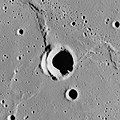Bonpland (crater)
 Lunar Orbiter 4 image | |
| Coordinates | 8°18′S 17°24′W / 8.3°S 17.4°W |
|---|---|
| Diameter | 60 km |
| Depth | Unknown |
| Colongitude | 17° at sunrise |
| Eponym | Aimé Bonpland |

Bonpland is the remains of a lunar impact crater that is attached to the walled plain Fra Mauro to the north and Parry to the east. The intersection of their rims forms a three-pointed mountainous rise. To the southeast is the small crater Tolansky, to the south are the wrinkly ridge of Dorsum Guettard and further west-southwest is Kuiper. Bonpland lies on the eastern edge of Mare Cognitum.

It is named after Aimé Bonpland, a French explorer and a botanist.
This rim of Bonpland is heavily worn and eroded, with the intrusion of Parry in the east creating a bulging extension to the southeast. The floor has been flooded by lava in the past, leaving a relatively flat surface that is broken by a series of narrow clefts. These are collectively designated the Rimae Parry. The clefts cross the rim to the south and also to the north, extending into the neighboring Fra Mauro.
Satellite craters
By convention these features are identified on lunar maps by placing the letter on the side of the crater midpoint that is closest to Bonpland. All of its satellite craters are south, southwest and west.
| Bonpland | Latitude | Longitude | Diameter |
|---|---|---|---|
| C | 10.2° S | 17.4° W | 4 km |
| D | 10.1° S | 18.2° W | 6 km |
| F | 7.3° S | 19.3° W | 4 km |
| G | 11.6° S | 18.8° W | 4 km |
| H | 11.4° S | 19.9° W | 4 km |
| J | 11.4° S | 20.4° W | 3 km |
| L | 7.5° S | 21.2° W | 3 km |
| N | 9.4° S | 21.4° W | 3 km |
| P | 10.9° S | 21.5° W | 1 km |
| R | 10.7° S | 18.6° W | 3 km |
The following craters have been renamed by the IAU.
- Bonpland E — See Kuiper (lunar crater).
-
Faulted crater Bonpland D
References
- Andersson, L. E.; Whitaker, E. A. (1982). NASA Catalogue of Lunar Nomenclature. NASA RP-1097.
{{cite book}}: Invalid|ref=harv(help) - Blue, Jennifer (July 25, 2007). "Gazetteer of Planetary Nomenclature". USGS. Retrieved 2007-08-05.
{{cite web}}: Invalid|ref=harv(help) - Bussey, B.; Spudis, P. (2004). The Clementine Atlas of the Moon. New York: Cambridge University Press. ISBN 978-0-521-81528-4.
{{cite book}}: Invalid|ref=harv(help) - Cocks, Elijah E.; Cocks, Josiah C. (1995). Who's Who on the Moon: A Biographical Dictionary of Lunar Nomenclature. Tudor Publishers. ISBN 978-0-936389-27-1.
{{cite book}}: Invalid|ref=harv(help) - McDowell, Jonathan (July 15, 2007). "Lunar Nomenclature". Jonathan's Space Report. Retrieved 2007-10-24.
{{cite web}}: Invalid|ref=harv(help) - Menzel, D. H.; Minnaert, M.; Levin, B.; Dollfus, A.; Bell, B. (1971). "Report on Lunar Nomenclature by the Working Group of Commission 17 of the IAU". Space Science Reviews. 12 (2): 136–186. Bibcode:1971SSRv...12..136M. doi:10.1007/BF00171763.
{{cite journal}}: Invalid|ref=harv(help) - Moore, Patrick (2001). On the Moon. Sterling Publishing Co. ISBN 978-0-304-35469-6.
{{cite book}}: Invalid|ref=harv(help) - Price, Fred W. (1988). The Moon Observer's Handbook. Cambridge University Press. ISBN 978-0-521-33500-3.
{{cite book}}: Invalid|ref=harv(help) - Rükl, Antonín (1990). Atlas of the Moon. Kalmbach Books. ISBN 978-0-913135-17-4.
{{cite book}}: Invalid|ref=harv(help) - Webb, Rev. T. W. (1962). Celestial Objects for Common Telescopes (6th revised ed.). Dover. ISBN 978-0-486-20917-3.
{{cite book}}: Invalid|ref=harv(help) - Whitaker, Ewen A. (1999). Mapping and Naming the Moon. Cambridge University Press. ISBN 978-0-521-62248-6.
{{cite book}}: Invalid|ref=harv(help) - Wlasuk, Peter T. (2000). Observing the Moon. Springer. ISBN 978-1-85233-193-1.
{{cite book}}: Invalid|ref=harv(help)


